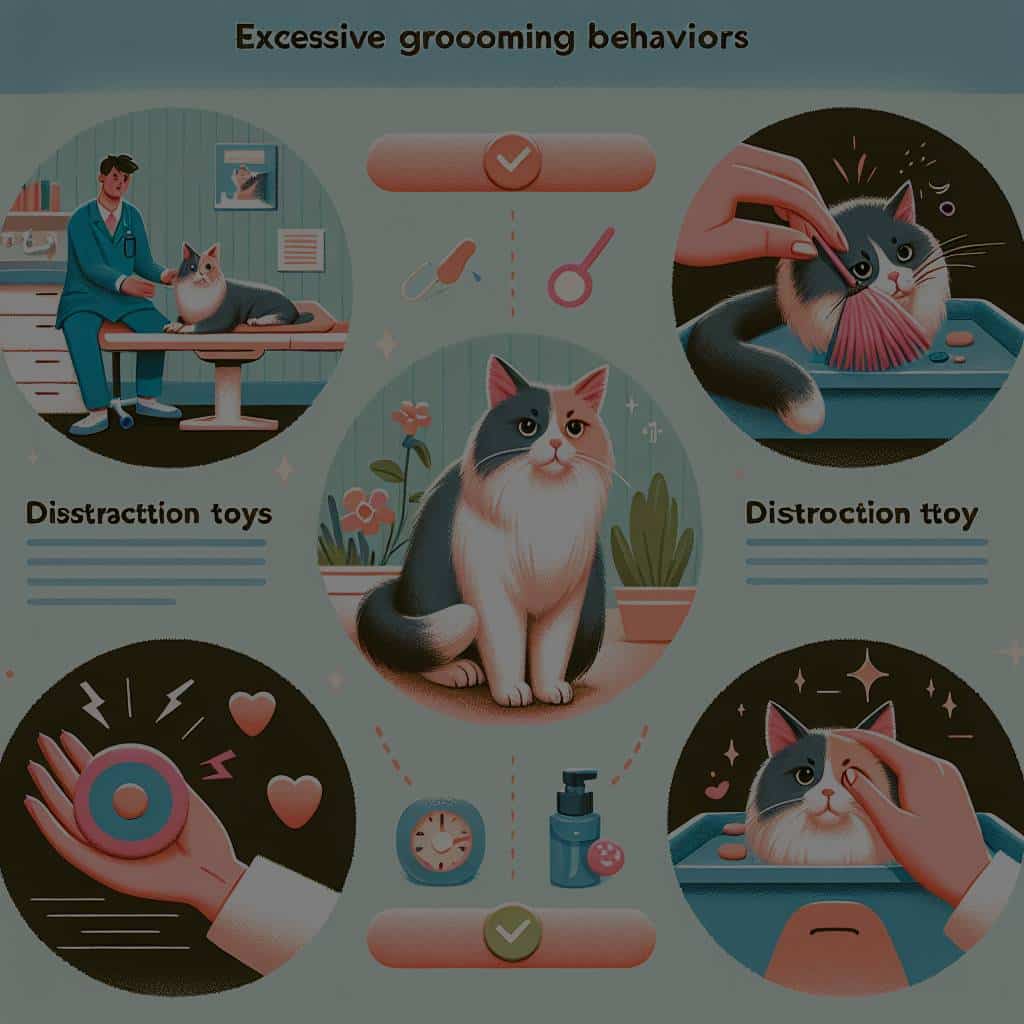How to Address Excessive Grooming Behaviors in Cats?

How does one deal with a cat that seems to be grooming excessively? Is there a problem? Should you be concerned? If you are a pet owner asking these questions, you’ve come to the right place. This article will delve into the world of pet behavior, particularly regarding cats and their grooming habits. We will explore what constitutes normal grooming, what’s considered excessive, and how you can address it.
Please remember: Don’t hesitate to consult with a vet if you notice any changes in your cat’s behavior or physical health. While it’s crucial to understand your pet’s behavior, it’s equally important to get professional help when necessary.
This might interest you : What Are the Best Natural Remedies for Flea and Tick Prevention in Dogs?
Understanding Normal Cat Grooming Behavior
For a start, it’s important to understand what normal grooming behavior looks like in cats. This will help you determine whether your pet is simply diligent about cleanliness, or if something more concerning is at play.
Cats are well-known for their cleanliness. Grooming is a natural behavior that serves several purposes such as removing parasites, distributing skin oils for a healthy coat, and for bonding when cats groom each other. A normal healthy cat spends around 30-50% of its waking hours grooming. Anything beyond this may be considered excessive.
Also read : What’s the Best Method for Potty Training a Puppy in an Apartment Setting?
Identifying Excessive Grooming
Spotting excessive grooming can sometimes be difficult as cats are often secretive creatures. However, if you see bald patches, red skin, or lesions on your cat, these could be signs of overgrooming. Your pet might be suffering from a medical condition or stress, causing it to groom excessively.
Overgrooming is the act of grooming to the point of self-harm. Cats that overgroom may cause skin irritations, open sores, or bald patches on their bodies. It’s not a behavior you should ignore. It requires attention and, in many cases, intervention.
Possible Causes of Overgrooming
It’s highly recommended to consult with a vet whenever you observe a change in your pet’s behavior. If your cat is displaying signs of overgrooming, there could be various reasons behind this behavior.
Common medical issues linked to overgrooming include skin allergies, parasites, and dermatitis. Behavioral issues such as anxiety, stress, or boredom can also lead to overgrooming. Sometimes, a change in the cat’s environment or food can trigger this behavior.
Medical Evaluation for Overgrooming
When you take your cat to the vet for a check-up, the vet will likely conduct a thorough examination in order to diagnose the root cause of the overgrooming. This might involve a skin scraping to check for mites or dermatitis, blood work to rule out allergies, and a complete physical examination.
The vet might also ask questions about your cat’s life at home. For example, have there been any recent changes in the environment? New pets or family members? Changes in the cat’s diet? This information will help the vet determine if the overgrooming is a result of behavioral issues or a medical condition.
How to Help Your Cat: Treatment Options
Once the vet has determined the cause of the overgrooming, a treatment plan can be formulated. If the cause is medical, the vet may prescribe medication or recommend changes in diet. The vet may also suggest preventative measures, such as flea and tick treatments.
If the overgrooming is deemed to be due to behavioral issues, the vet may recommend a visit to an animal behaviorist. An expert in animal behavior can help uncover the root of your cat’s stress or anxiety and suggest solutions like new toys, more playtime, or even medication to help alleviate stress.
Remember, excessive grooming in cats is not a behavior to be overlooked. It’s important to remain vigilant about your cat’s overall health and well-being. Regularly observe your cat’s grooming habits, and always consult with a vet if something seems off. This way, you can ensure your furry friend stays happy, healthy, and comfortably groomed.
Dealing with Psychogenic Alopecia
Psychogenic alopecia, a condition resulting from compulsive grooming, is one of the primary concerns when a cat overgrooms. It is typically a behavioral issue, but it can also manifest due to underlying medical conditions.
Cats with psychogenic alopecia usually groom so excessively that they create bald patches on their bodies, most commonly on the belly, inside of the thighs, or along the forelimbs. This condition can cause itchy skin and skin irritation, leading to an uncomfortable situation for the cat.
Firstly, it’s essential to rule out any physiological causes. A vet will often perform a series of tests to look for any underlying medical issues such as dermatitis or allergies. When these are ruled out, psychogenic alopecia is usually determined to be a behavioral problem.
The potential causes can range from a change in the household like a new pet, a new baby, or even a change in the litter box. Such changes can lead to stress or anxiety in cats, which they often cope with by excessive grooming.
If your cat is diagnosed with psychogenic alopecia, the treatment plan will depend on the underlying issue. If it’s due to stress or anxiety, changes in the environment, increasing playtime, or therapeutic toys might help. In certain cases, the vet might even prescribe medication to alleviate the stress or anxiety.
Conclusion: Maintaining a Healthy Grooming Routine
While grooming is an inherent aspect of a cat’s life, it’s crucial to observe and understand the signs of overgrooming. Cats often use grooming as a coping mechanism, which can lead to excessive grooming and, in some cases, even psychogenic alopecia.
If you notice signs of overgrooming, such as bald patches, skin irritation, or changes in behavior, it’s best to consult with a professional. A vet can help determine if the cause is an underlying medical condition or a behavioral issue.
In many cases, the situation can be controlled with appropriate treatment, be it medical intervention or environmental changes. The key is early detection. As pet owners, we hold the responsibility for our pet’s health and well-being. Therefore, we must be attentive and proactive.
Finally, remember that grooming cats is a natural behavior, but overgrooming cats is not. Excessive grooming is a sign that your cat may need help. Through careful observation, prompt action, and professional consultation, you can ensure your cat’s comfort and health.
Image credit: A well-groomed cat is a happy cat, and a happy cat makes for a happy home.
